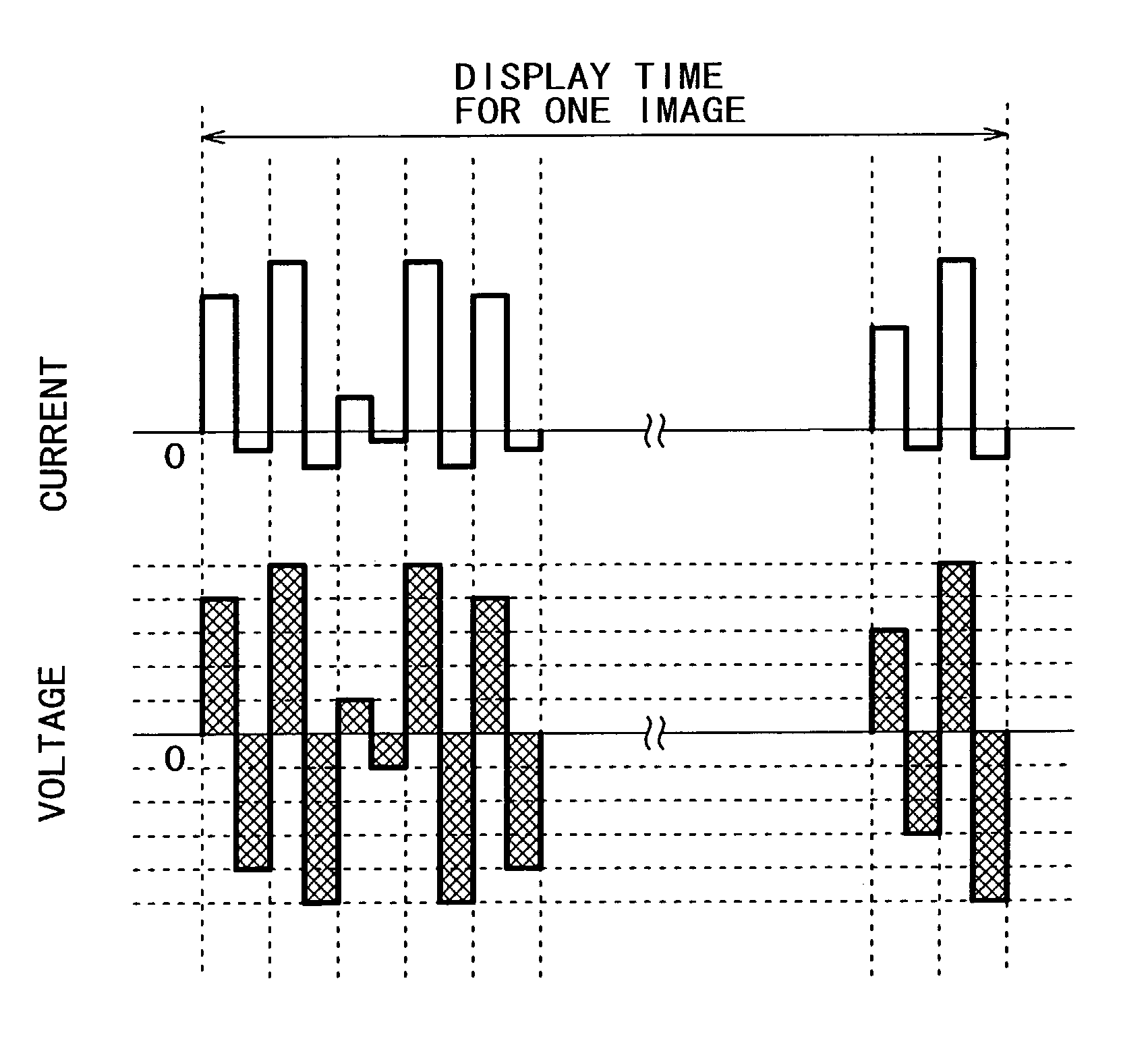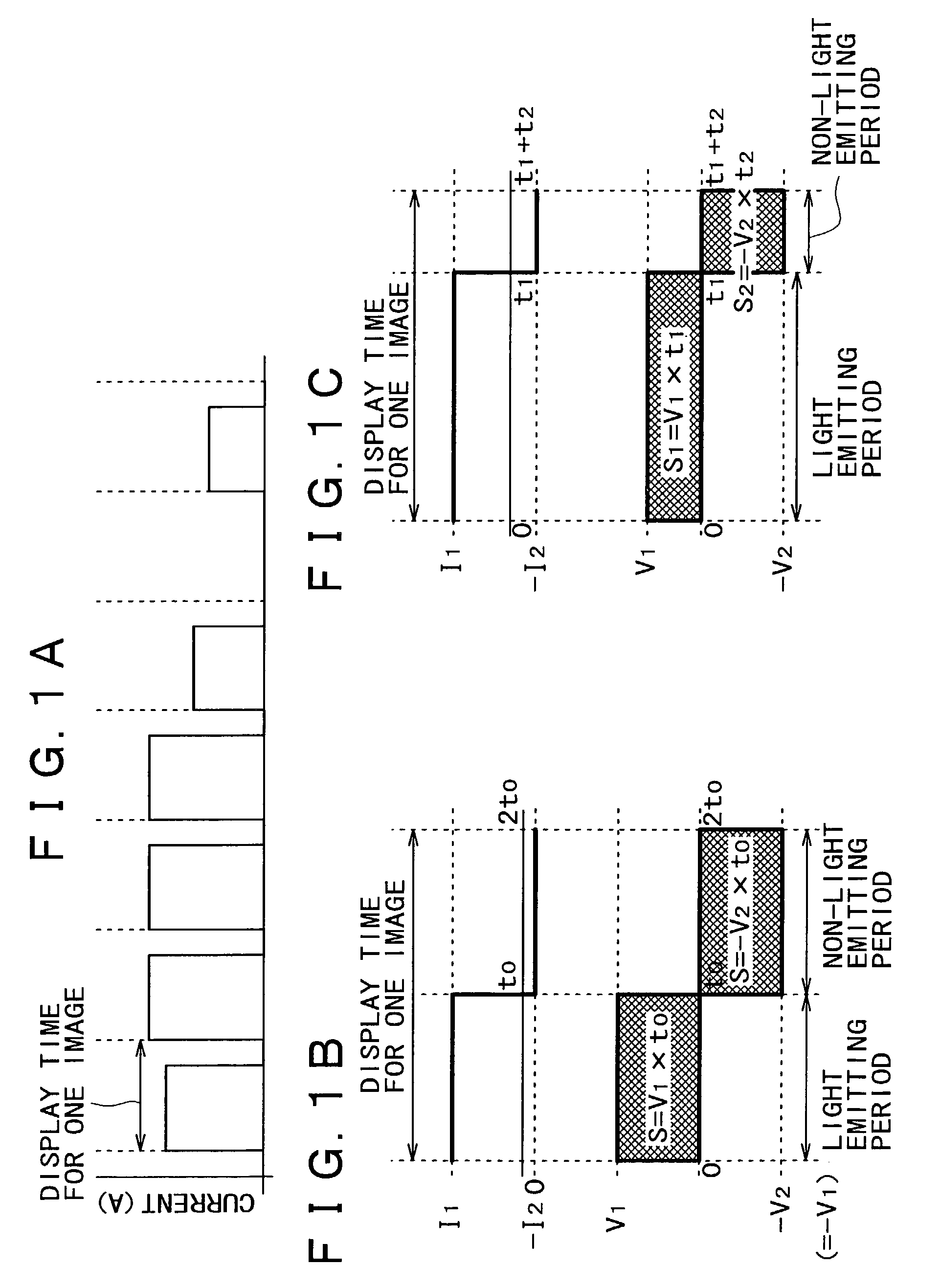Method of driving electroluminescent device
- Summary
- Abstract
- Description
- Claims
- Application Information
AI Technical Summary
Benefits of technology
Problems solved by technology
Method used
Image
Examples
examples 1-9
[0143]In each of these examples, the organic EL device having the device structure 1 was driven with current control based on a rectangular bipolar type current waveform shown in FIG. 15A.
[0144]As shown in FIG. 15A, a one image display period was taken as 16.7 ms at a frequency of 60 Hz, whereby an image display time in the one image display period was in a range of 0 to 16.7 ms.
[0145]The duty ratios were set to 5%, 10%, 30%, 50%, 70%, 75%, 80%, 90%, and 95% for Examples 1 to 9, respectively, whereby the one image display period in each of Examples 1 to 9 was divided into 5% (10%, 30%, 50%, 70%, 75%, 80%, 90%, 95%) of a light emitting period and 95% (90%, 70%, 50%, 30%, 25%, 20%, 10%, 5%) of a non-light emitting period. With such a duty ratio, the initial luminance became 100 cd / m2.
[0146]Further, in each of Examples 1 to 9, the waveform was set to a rectangular bipolar type current waveform shown in FIG. 15A. To be more specific, a current value in the non-light emitting period was ...
examples 10 to 12
[0154]In each of these examples, the organic EL device having the device structure 1 was driven with current control based on a rectangular bipolar type current waveform shown in FIG. 16A.
[0155]As shown in FIG. 16A, a one image display period was taken as 16.7 ms at a frequency of 60 Hz, whereby an image display time in the one image display period was in a range of 0 to 16.7 ms.
[0156]The duty ratio was set to 50%, whereby the one image display period was divided into 50% of a light emitting period and 50% of a non-light emitting period, and further, the waveform in the image display period was divided into two for Example 10, into five for Example 11, and divided into ten for Example 12, with the voltage and current values in each waveform kept constant. With such a duty ratio, the initial luminance became 100 cd / m2.
[0157]Further, in each of Examples 10 to 12, the waveform was set to a rectangular bipolar type current waveform shown in FIG. 16A. To be more specific, a current value...
example 13
[0164]In this example, the organic EL device having the device structure 2 was driven with current control based on a rectangular bipolar type current waveform shown in FIG. 17.
[0165]As shown in FIG. 17, a one image display period was taken as 16.7 ms at a frequency of 60 Hz, whereby an image display time in the one image display period was in a range of 0 to 16.7 ms.
[0166]The duty ratio was set to 50%, whereby the one image display period is divided into 50% of a light emitting period and 50% of a non-light emitting period. With this duty ratio of 50%, the initial luminance became 100 cd / m2.
[0167]Further, the waveform was set to a rectangular bipolar type current waveform shown in FIG. 17. To be more specific, a current value in the non-light emitting period was set such that the integral intensity of a voltage that corresponds to a current value in the light emitting period is substantially canceled by the integral intensity of a voltage that corresponds to the current value in th...
PUM
 Login to View More
Login to View More Abstract
Description
Claims
Application Information
 Login to View More
Login to View More - R&D
- Intellectual Property
- Life Sciences
- Materials
- Tech Scout
- Unparalleled Data Quality
- Higher Quality Content
- 60% Fewer Hallucinations
Browse by: Latest US Patents, China's latest patents, Technical Efficacy Thesaurus, Application Domain, Technology Topic, Popular Technical Reports.
© 2025 PatSnap. All rights reserved.Legal|Privacy policy|Modern Slavery Act Transparency Statement|Sitemap|About US| Contact US: help@patsnap.com



